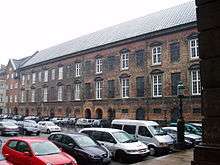Danish National Archives
Danish National Archives (Danish: Rigsarkivet) is the national archive system of Denmark. The primary purpose is to collect, preserve and archive historically valuable records from central authorities, such as ministries, agencies and national organisations and make them available to the public. The archive is part of the Ministry of Culture.
| Danish: Rigsarkivet | |
 Danish National Archives, Copenhagen. One of four reading rooms that make up the archive's system. | |
| Agency overview | |
|---|---|
| Formed | 1889 |
| Preceding agencies |
|
| Jurisdiction | Government of Denmark |
| Headquarters | Copenhagen, Denmark |
| Employees | 260 |
| Agency executive |
|
| Parent department | The Ministry of Culture |
| Website | www |
Previously the term Danish State Archives (Danish: Statens Arkiver) was used as the collective name for the archive system. In 2014 the archives were reorganised, and the name Rigsarkivet (which had previously only applied to the Danish National Archives in Copenhagen) became the new collective name for the entire archive system.
History
Organisation as the Danish State Archives
Prior to 2014, Danish State Archives was the term used to refer collectively to these archives:
- Danish National Archives (Copenhagen)
- Danish Data Archives (Odense)
- Danish National Business Archives (Aarhus)
- Regional Archives:
- Provincial Archives of Zealand, Lolland-Falster and Bornholm (Copenhagen), closed in 2012 when its collections were merged with the Danish National Archives in Copenhagen.
- Provincial Archives of Southern Jutland (Aabenraa)
- Provincial Archives of Funen (Odense)
- Provincial Archives of Northern Jutland (Viborg)
Regional archives held records transferred from regional authorities, like courts of law, the county authorities, the police and many other local authorities. Records from central authorities, such as ministries, agencies and national organisations, were held at the Danish National Archives. The Danish National Business Archives kept registers, documents, etc. from companies and organisations in the business sector. The Danish Data Archives, the newest of the seven archive holding bodies, kept historical and social science studies such as registers, databases and other electronically stored information.
Reorganisation in the 2010s
In 2014, the Danish State Archives were reorganised, and the separate archives became reading rooms in a larger archive system. On 1 October 2014, the name Danish State Archives (Danish: Statens Arkiver) was replaced with the name Danish National Archives (Danish: Rigsarkivet).[2] The new Danish National Archives were organised as:
- Danish National Archives, Copenhagen (formerly the Danish National Archives in Copenhagen, which had absorbed the collections of the Provincial Archives of Zealand, Lolland-Falster and Bornholm in 2012)
- Danish National Archives, Aarhus (formerly the Danish National Business Archives)
- Danish National Archives, Aabenraa (formerly the Provincial Archives of Southern Jutland)
- Danish National Archives, Odense (formerly the Provincial Archives of Funen)
- Danish National Archives, Viborg (formerly the Provincial Archives of Northern Jutland)
In 2015, Danish National Archives, Aarhus was closed and its collections were moved to Danish National Archives, Viborg.[3]
Reading Rooms
Today the Danish National Archives includes four reading rooms (Copenhagen, Aabenraa, Odense, and Viborg).
Danish National Archives, Copenhagen
Location
The headquarters of the Danish National Archives, Copenhagen are located next to Christiansborg Palace on Slotsholmen. A new purpose-built storage building was opened in 2009 at Kalvebod Brygge. It was designed by PLH Arkitekter.
History
The archive was founded in 1889 out of two older national archives, Gehejmearkivet (1296-1883) and Kongerigets arkiv (1861-1884). In 2012 the collections of the Provincial Archives of Zealand, Lolland-Falster and Bornholm were merged into the Danish National Archives. In 2014, the Danish National Archives was renamed Danish National Archives, Copenhagen and the term Danish National Archives came to represent all former Danish State Archives.
Collections
The Danish National Archives, Copenhagen holds the archives of the Danish overseas trading companies, including the archives of the Danish East India Company, the Danish Asiatic Company, the Danish West India and Guinea Company and the Danish West India Trading Company, and reflects Denmark's relations with foreign countries such as the European States, Russia, Turkey, North African states and the American states. The archives of the Danish overseas trading companies were inscribed on UNESCO’s Memory of the World Register in 1997.[4]
The Sound Toll Records, which provide detailed information about every ship and cargo that entered the Baltic and departed from the Baltic through the Danish straits starting in the 15th century, are held at the Danish National Archives and in 2007, the collection was inscribed on the Memory of the World Register.[5]
Storage
The documents are stored on electrically powered mobile shelving – double-sided shelves, which are pushed together so that there is no aisle between them. A large handle on the end of each shelf allows them to be moved along tracks in the floor to create an aisle when needed. The units have a small AC or DC motor hidden in the base that automatically moves the units when a single button is pressed.
References
| Wikimedia Commons has media related to Danish National Archives. |
- "Ny øverste chef til Rigsarkivet". www.sa.dk. Rigsarkivet. 25 October 2018. Retrieved 23 February 2019. (In Danish)
- "Statens Arkiver bliver til Rigsarkivet". www.sa.dk. Rigsarkivet. 24 October 2014. Archived from the original on 29 October 2014. Retrieved 24 February 2019. (In Danish)
- "Ny magasinplads skal sikre arkivalier for eftertiden". www.sa.dk. Statens Arkiver. 23 September 2014. Archived from the original on 17 March 2015.CS1 maint: unfit url (link) (In Danish)
- "Archives of the Danish overseas trading companies". UNESCO Memory of the World Programme. 2008-06-04. Archived from the original on 2008-06-23. Retrieved 2009-12-15.
- "Sound Toll Registers". UNESCO Memory of the World Programme. 2008-05-16. Archived from the original on 2009-08-05. Retrieved 2009-12-15.